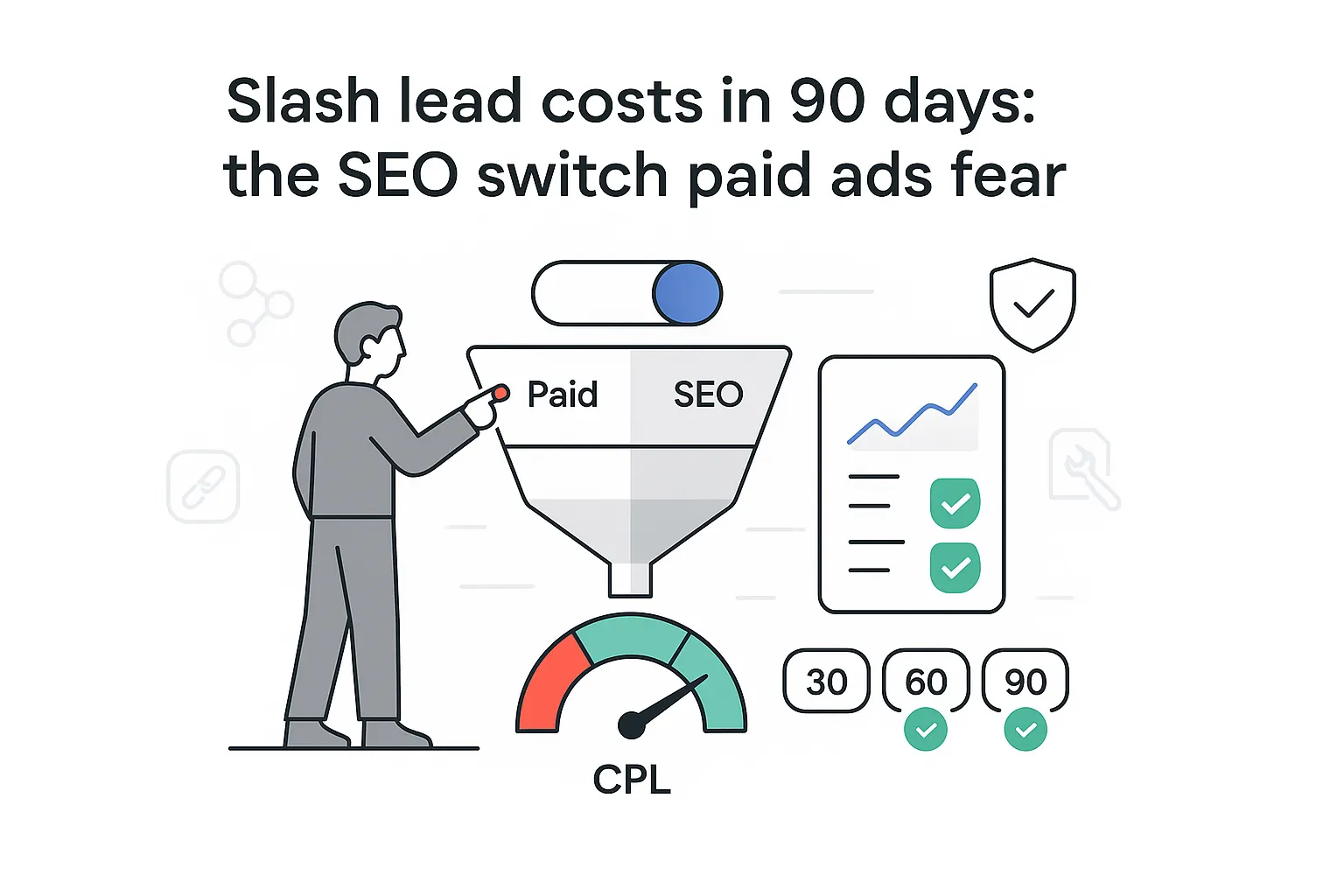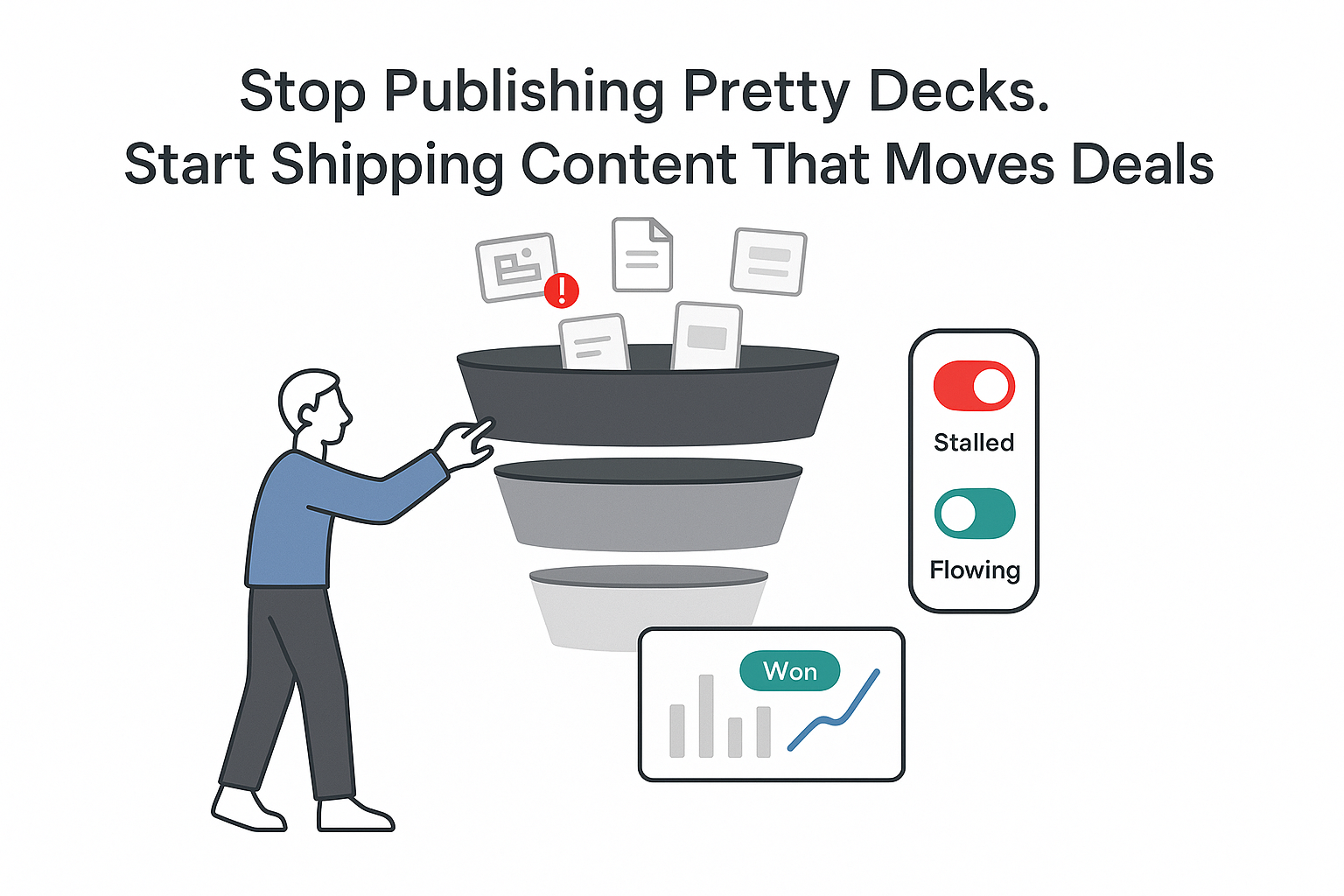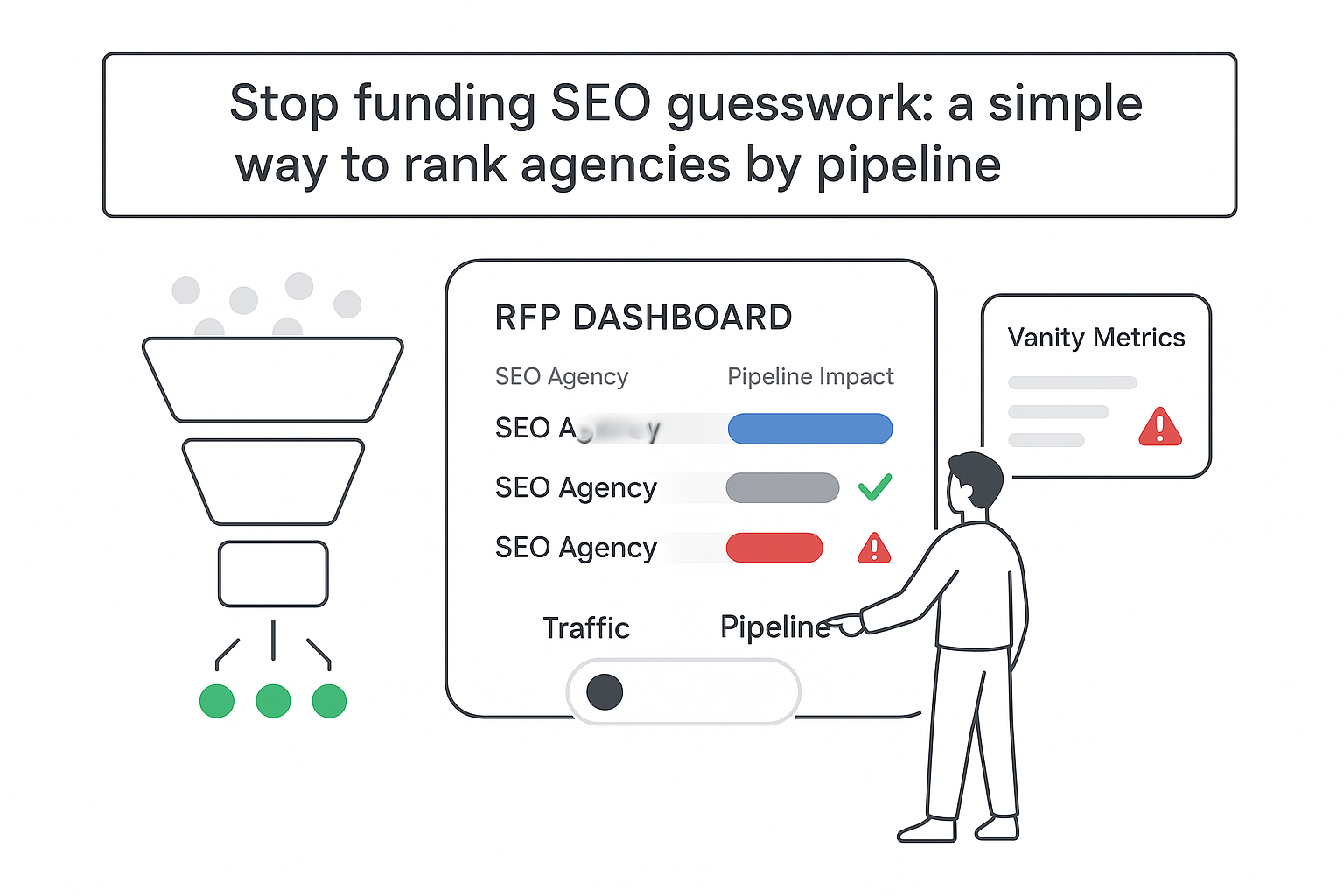Executive summary: B2B SEO for service companies
I design SEO programs that feed the pipeline without constant babysitting. I prioritize faster time to first signal, sales-ready leads, lower cost per lead (CPL) than paid, and proof that organic activity affects revenue. The sequence is simple: start with revenue pages, fix technical hygiene, earn relevant links, then scale with clear reporting and a plan your team actually follows.
CEOs ask the same four questions: How soon will we see movement? Will the leads be sales-ready? Will this lift pipeline, not just traffic? How does CPL compare to paid? The short version: with focused B2B SEO for service companies, I typically ship signal in 30 days and create measurable pipeline in 60–90 days, with CPL at a fraction of paid once core pages rank. Time to value varies by domain strength, competitive intensity, and content velocity - smart sequencing and tight execution reduce the variance.
Ownership model
- Executive sponsor sets goals and budget, then avoids the weeds.
- SEO lead owns strategy, forecasting, and prioritization.
- Content lead manages briefs, SME interviews, and publishing cadence.
- Developer handles site fixes, schema, and performance.
- Analytics owner connects CRM and analytics, validates conversions, and reports.
30, 60, 90 day milestones (typical example)
- 30 days: technical blockers removed, analytics fixed, first batch of bottom-of-funnel (BOFU) pages live, early internal links in place.
- 60 days: comparison and industry pages indexed, ranking lift on service terms, first qualified form fills, first links published.
- 90 days: BOFU clusters in top 10 for target geos, steady MQLs (marketing qualified leads) and SQLs (sales qualified leads), sourced and influenced pipeline visible in CRM, content refreshes begin to compound.
Quick wins to push live
- Fix indexation and canonical issues in Search Console and sitemaps.
- Upgrade service pages with benefits, proof, and conversion sections.
- Launch comparison and alternative pages for core competitors.
- Add internal links from blogs, case studies, and navigation to money pages.
- Tighten conversion tracking with GA4, CRM, and form enrichment.
Technique #1: keyword research
Pipeline comes first. That means starting with BOFU service and comparison queries, not generic topics. For B2B SEO for service companies, this alone improves time to value and keeps effort aligned with revenue.
How to pick the right terms
- Prioritize pain words your ICP actually uses: cost, timeline, integrations, compliance, migration, security, onboarding.
- Analyze SERP intent: if top results are service providers and comparison guides, ship a page. If results mix listicles with a few providers, start with a strong section on the service page and expand when intent shifts.
- Use programmatic grouping (e.g., Ahrefs/Semrush) to find patterns, then sanity check with Search Console data and sales call notes.
Deliverables worth keeping
- Keyword-to-page map assigning one core intent per URL.
- Opportunity score that blends volume, intent strength, competitiveness, and revenue fit. Keep the math simple and consistent.
- Cluster-level briefs with title angles, subtopics, proof points, and internal link targets.
Gap analysis
Ignore vanity keywords. Compare your keyword-to-page map with competitor pages by funnel stage. If they rank with thin or misaligned content, ship stronger assets and connect them with purposeful internal links.
Technique #2: content strategy
I build revenue pages first, then the assets that support and amplify them. That is where B2B SEO for service companies outperforms generic blogging and starts feeding sales.
Pages to build in the first push
- Service pages: one per core service with proof, process, FAQs, and pricing context.
- Solutions by industry or segment: reflect risks, language, and outcomes clients care about.
- Use cases: framed by job-to-be-done.
- Comparison and alternatives: fair and useful, not snarky.
- Pricing: even if it is ranges or packages, with notes on variables.
- Case studies: one page per client story with challenge, action, and outcomes.
- FAQs: address objections sales hears weekly.
Make it repeatable with a task chain
Research, outline, SME interview, draft, compliance and brand QA, publish, internal links, refresh cadence. It sounds basic, yet it saves weeks and makes delivery predictable.
E-E-A-T that feels real
- Author bios with role and experience.
- Citations to standards and regulations your buyers trust.
- Proprietary data or aggregated insights from your pipeline.
- Quotes from SMEs, sales leaders, or clients.
Internal linking blueprint
- Hub-and-spoke: service hubs link to use cases and industry pages, and back.
- Breadcrumbs that reflect your information architecture.
- Navigation links that elevate money pages without bloating menus.
Measurement that matters
Track publish velocity by page type and enforce refresh intervals. If a page hits page two, refresh. If it drops, investigate cannibalization and links. Tie all effort back to rankings and leads, not just pageviews.
Technique #3: technical SEO
Technical work should be short, sharp, and tied to revenue. I fix what blocks crawling, indexing, and conversions - then ship. That is the heart of technical SEO for B2B service sites.
Priority fixes
- Log files: spot crawl waste and blocked money pages.
- XML sitemaps: split by type and include only index-worthy URLs.
- Canonical hygiene and duplicate control: watch parameters and CMS quirks.
- Core Web Vitals: focus on LCP, CLS, and TTFB on money pages first.
- JavaScript rendering: pre-render if needed so content is parseable by crawlers.
- Schema: Organization, Service, FAQ, Review, and Breadcrumb where relevant.
- Hreflang: for multiple English-speaking regions with localized pages.
Site architecture
Keep money pages close to the root with flat depth. Use clean URL paths that match hubs. Avoid orphan pages by running site crawls weekly during active changes.
QA without drama
Automate checks pre- and post-deploy. Performance budgets, noindex/canonical audits, and title/description diffs prevent regressions. Keep a simple change log.
Deliverables
An 80/20 technical action list with tags for business impact, traffic risk, and expected conversion lift so everyone understands why each fix matters.
Technique #4: link building
Links still move rankings, but random volume does little. For B2B SEO for service companies, contextual credibility beats shotgun outreach.
Where good links come from
- Industry publications and analyst blogs.
- Partner co-marketing: joint use cases, integration guides, and customer wins.
- Customer success stories on client sites that reference your case study.
- Founder-led thought leadership with useful data or frameworks.
- Data PR: short benchmarks or one-page reports with a clear story.
- Vetted niche directories, not junk lists.
Outreach assets
- Value-first email: a concise angle and clear benefit to their readers.
- Anchor policy: mix brand, partial, and generic anchors; avoid stuffing exact match.
- Page selection: prioritize deep pages that drive pipeline, not just the homepage.
Competitive gap audit
Find pages competitors earned links to and rebuild something better. Original research, short benchmarks, ROI stories, and integration explainers earn links faster than generic posts.
Measurement
Track referring domains, link velocity, and topical authority signals. Monitor new links monthly and set targets that match ranking goals.
Technique #5: SEO ROI
No trust without numbers. I use a simple model that shows how rankings turn into revenue, with assumptions documented and easy to audit.
Measurement model
- Assisted and direct pipeline: both sourced and influenced.
- Form-fill quality: scrub spam and enrich with CRM rules.
- Meeting set rate and show rate.
- Sales cycle length and average contract value (ACV).
- Content-assisted deals: count touchpoints without inflating credit.
OKRs that point to money
- Top-10 rankings for BOFU clusters within 90 days where feasible.
- MQL and SQL volumes that match ICP criteria.
- Pipeline dollars by month: sourced and influenced, with snapshots.
Attribution alignment
Map UTMs to page types, align GA4 conversions with CRM stages, import offline conversions, and maintain consistent fields for first touch, last touch, and content touched. Naming standards keep reports readable and auditable.
Quality standards
- Content must match search intent and pass a two-minute accuracy skim.
- CRO checkpoints: clear headline, proof above the fold, social proof, pricing context, strong form, no dead ends.
Report cadence
- Weekly leading indicators: indexation, rankings, CTR, publish count, link count.
- Monthly outcomes: leads, opportunities, pipeline, revenue.
- Quarterly strategy reset: what moved, what stalled, what to double down on.
Breakeven math
Break-even SQLs for a period = Cost for that period ÷ (ACV × SQL-to-close rate).
Example: if monthly SEO is 15k, a quarter is 45k; ACV is 40k; SQL-to-close is 25%. Break-even SQLs ≈ 45,000 ÷ (40,000 × 0.25) = 4.5, so about five SQLs to break even in a quarter. Pilot first, then scale when unit economics hold.
Methodology and case studies
Where the inputs come from
- Competitive SERPs: top ranking pages and their structure.
- First-party analytics and CRM: what converts, where it came from, how long it took.
- Sales interviews: what prospects ask, what they compare, and what stalls deals.
Testing methods I like
A/B tests for titles and meta descriptions, controlled internal link changes, scheduled content refreshes. For tracking, I align Search Console, GA4, and CRM reporting, with dashboarding to keep trends visible and crawls to catch regressions. Governance lives in versioned docs so changes are clear.
Mini case snapshots (anonymized)
- B2B cybersecurity services: initial state - thin service pages, slow site. Actions - shipped four revenue pages, added comparison pages, fixed CLS on templates, landed five links from security blogs. 90-day results - top 10 for three service terms, 38 qualified leads, $1.2M influenced pipeline.
- Logistics consulting: initial state - blog-heavy, no case studies, messy tracking. Actions - launched three case studies, rebuilt pricing and FAQs, repaired UTM naming and CRM fields, ran partner co-marketing with two links. 90-day results - meetings up 31%, five SQLs traced to comparison pages, two deals closed.
- Healthcare IT services: initial state - duplicate pages, JavaScript rendering issues. Actions - canonical fixes, pre-rendering critical content, added Service and FAQ schema, released industry pages with SME quotes. 90-day results - index coverage normalized, 24% lift in organic traffic to money pages, seven opportunities created.
References for further reading
- Google Search Central: crawling, indexing, and structured data documentation.
- GA4 help center: conversion setup and offline import guidance.
- Ahrefs and Semrush: keyword research and link analysis guides.
- Screaming Frog: technical auditing resources.
- HubSpot and Salesforce: attribution and CRM data alignment notes.
Conclusion: B2B lead generation
This system has five moving parts that work together: keyword research, content strategy, technical fixes, links, and clear ROI tracking. Expect first signals in 30 days, early pipeline impact in 60–90 days, and compounding gains as pages refresh and links accrue. It is not instant, but it is steady and transparent when execution stays tight.
90-day action plan
- Ship 10–15 launches or refreshes across service, comparison, industry, and case study pages.
- Fix 3–5 technical issues that block indexing or slow money pages.
- Earn 10+ authoritative links from credible sources.
- Clean up analytics, UTMs, and CRM fields so attribution is dependable.
Risk controls
Set scope guardrails per sprint, keep a change log, and have a rollback plan for big template shifts. Small batches reduce surprises and accelerate learning.







.svg)